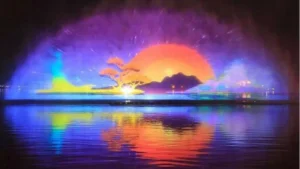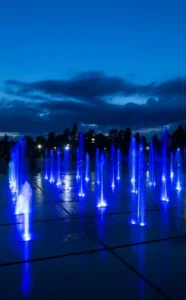- Product Knowledge
Media Facade Lighting: The Art and Science of Transforming Buildings into Digital Displays
Media facade lighting is revolutionizing the way we look at architecture, blending art, technology, and sustainability. But what exactly is it, and why has it become such a game-changer in urban landscapes around the world? Let’s break it down.

What Is Media Facade Lighting?
Media facade lighting refers to the integration of LED or other advanced lighting technologies into the exteriors of buildings. This allows skyscrapers, commercial complexes, and cultural institutions to transform their outer surfaces into dynamic, visually stunning displays. From changing colors to animations and even interactive content, media facade lighting offers endless possibilities for creative expression.
In cities like Dubai, New York, and even across India, this technology is helping buildings become more than just structures—they’re becoming living, breathing canvases. Not only do these systems enhance the aesthetics, but they can also serve practical purposes. With programmable LED lights that consume less power, media facades promote energy efficiency while still providing eye-catching visuals.
Moreover, these lighting systems can be customized to suit any event, season, or theme, making them highly versatile. Whether you’re looking to create a holiday-themed display or celebrate a local event, media facade lighting offers unmatched flexibility. And with smart technology integrations, they can be controlled remotely and adjusted automatically based on natural light conditions, reducing energy consumption even further.
Key Features of Media Facade Lighting
So, what makes media facade lighting so special? Here are some key features that make it a popular choice for modern architecture:
1. Dynamic Displays
One of the standout features of media facades is their ability to display a wide range of content. From animations to live-streamed video, the options are nearly limitless. Buildings equipped with these systems can transform their appearance instantly, projecting anything from advertisements to public service messages. In places like India, this technology is being used to create both artistic displays and commercial advertisements on large-scale buildings.
2. Interactive Elements
Some media facades take it up a notch by incorporating interactive technology. Using sensors and touch-sensitive panels, these facades can react to movement or environmental conditions. Imagine walking past a building and seeing the lights shift in response to your motion—this level of interactivity creates an immersive experience for onlookers. In cities like Dubai, interactive facades are enhancing the viewer experience, creating a stronger connection between the public and the building.
3. Seamless Architectural Integration
A well-designed media facade doesn’t just sit on top of a building—it becomes a part of the architecture itself. Lighting elements are carefully integrated into the building’s exterior design, enhancing its structure rather than detracting from it. Many media facade lighting companies in India specialize in this seamless blending of light and architecture, ensuring that the technology complements the building’s original design.
4. Technological Advancements
At the heart of media facade lighting systems are high-tech components like LED panels, control software, and sometimes network connectivity. More advanced systems may even include projection mapping to create 3D visual effects. These systems are designed for easy updating and customization, making it simple to change content without the need for extensive manual adjustments.
Applications of Media Facade Lighting
The beauty of media facade lighting is in its versatility. Here are just a few ways it’s being used in modern architecture:
- Advertising: Buildings with media facades can easily double as billboards, displaying ads in prime urban locations.
- Public Art Installations: Many cities use media facades to display works of art, creating a gallery experience right on the streets.
- Event Promotion: Media facades are ideal for promoting local events, holidays, or special occasions with custom animations and colors.
- Building Identity: Want your building to stand out in a sea of skyscrapers? Media facades make it possible by creating a unique, attention-grabbing appearance.
The Energy Efficiency Advantage
One of the most appealing aspects of media facade lighting is its focus on energy efficiency. Traditional lighting systems can be power-hungry and expensive to maintain, but with LED technology, power consumption drops significantly. This makes media facades not only a creative investment but a financially smart one, too.
LEDs also have a longer lifespan than traditional lighting systems, reducing the need for frequent replacements and maintenance. Plus, their programmability allows for on-the-fly adjustments to brightness levels, ensuring that energy is only used when needed. It’s a win-win for both aesthetics and the environment.
Benefits of Media Facade Lighting
Enhanced Aesthetics
By turning otherwise ordinary buildings into iconic landmarks, media facades help draw attention and make a lasting visual impact. Just look at the examples of media facade lighting in Dubai—these structures have become not just buildings but part of the city’s identity.
Versatility
Whether it’s an art installation or a corporate message, media facades offer flexibility in what can be displayed. Content can be easily updated, allowing buildings to keep up with changing seasons, holidays, and special events.
Increased Engagement
Interactive media facades bring a whole new level of engagement to public spaces. Whether it’s responding to human movement or environmental factors like temperature or wind, these facades create a more dynamic interaction between the viewer and the structure. In a world where attention spans are shorter than ever, this kind of interaction is crucial for creating memorable experiences.
In Conclusion (Or, Why Media Facades Matter)
Media facade lighting isn’t just about adding some flashy lights to a building. It’s about merging technology, art, and architecture to create structures that are not only functional but also visually engaging and energy-efficient. These systems offer a canvas for creative expression while promoting sustainability through their efficient use of energy.
As the technology continues to evolve, the potential applications of media facade lighting are only expanding. Whether you’re looking to create a stunning landmark, engage with the public, or simply reduce your building’s energy consumption, media facade lighting offers an innovative solution.



